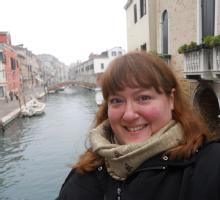Emily Price - Warwick/Newberry Visiting Research Fellow, Autumn 2011
I am a doctoral candidate in history at the University of Michigan. My research concerns pilgrimage shrines to the Holy House, the supposed site of the Annunciation and childhood home of both the Virgin Mary and Jesus Christ. My dissertation, “Authenticity, Domesticity, and the Holy House in England and Italy, 1350-1650,” examines the ways in which domestic buildings were transformed into sacred spaces, and how they became sites around which early modern people constructed narratives of reform and counter-reform.
The Warwick/Newberry Visiting Research Fellowship allowed me to spend eleven weeks in residence in Venice, where I conducted research at several Venetian libraries; visited my Italian research site in Loreto, the Marches; and participated in the life of the Warwick-in-Venice program.
While in Venice, I focused my research on early modern histories of the Loreto shrine, pilgrims’ accounts and miracle stories, and pilgrim souvenirs produced by the shrine. I spent most of my time at the Biblioteca Nazionale Marciana, which holds original copies, in manuscript and print, of sixteenth and seventeenth century histories of Loreto, and descriptions of the shrine written by early modern pilgrims. This research will form one of my dissertation chapters, in which I will examine the ways in which these histories depict the Loreto House as an “authentic” site for devotion to the Holy Family. Since many of these histories were written by humanist scholars, a group concerned with developing new ways of relating to the past, I am particularly interested in how they attempt to prove the House’s antiquity, and how they claim the authority of the Holy Land for the site.
I also spent many hours at the library of the Fondazione Giorgio Cini, where I consulted Italian studies of pilgrimage souvenirs, including catalogues of souvenirs held in many small or obscure Italian collections that I had not been able to access in America. I was also able to study fifteenth and sixteenth century woodcuts from Loreto: these woodcuts will add an entirely new dimension to my dissertation chapter on pilgrimage souvenirs. Along with similarly inexpensive lead and pewter badges, woodcuts were purchased by ordinary pilgrims who wanted to commemorate a particular aspect of their journey. My chapter will explore the ways in which these objects allowed users to reconstruct their voyages in their own domestic space.
At the Archivio di Stato in Venice, I was able to consult ambassadorial letters that mention Loreto, which will help me to understand the means by which Loreto was transformed from a local shrine into an international one, and how it was viewed and used by papal and other political authorities. It is particularly intriguing to note the ways in which the Loreto House seems to have been a focus for imaginative projection: the House was supposed to have been miraculously transported to Italy from Nazareth when threatened by Muslim incursions in 1291, and in later centuries, it became a rallying point for attempted “crusades” against the Ottoman Empire.
The fellowship also allowed me to make an extended research trip to Loreto. It was immensely valuable for me to spend time actually within the space of the little building that is supposed to be the original Holy House, and in the basilica that surrounds it. In the archives of the shrine, I consulted sixteenth century inventories of objects donated to and manufactured by the church, which will be critical for understanding increasing devotion to the Holy House, and may also provide information about the manufacture of pilgrim souvenirs. I also found evidence of legal disputes between the citizens of Loreto, the keepers of the shrine, and the papacy, which I hope will give me more insight into souvenir production.
I was also able to look at documents from the fifteenth and sixteenth centuries that detailed the process of building the enormous basilica, and the various ways in which the space of the Holy House was enclosed and altered. This evidence will help me draw conclusions about the demands of lay worshippers and the desires of the shrine’s caretakers, and the ways in which domestic space was sanctified at the shrine. It will take me many more months to work through the vast pile of archival material that I uncovered in Loreto.
Apart from being able to gather such rich material for my dissertation, I benefited greatly from the collegial Warwick-in-Venice program itself: the professors and staff, particularly Dr Louise Bourdua and Dr Donal Cooper, and the masters and doctoral students formed a supportive and stimulating community that I relied on. I welcomed the opportunity to present some of my preliminary findings on the role of woodcuts and pilgrim badges in early modern religious practices at Warwick’s annual Convegno: the dissertation chapter that will come out of this research will be much improved thanks to the comments I received.
During my time in Venice, I made several connections with other medieval and early modern scholars, both at Warwick and in the course of working in the archives, that will greatly enrich my work. The material that I gathered and the connections that I formed through my Visiting Research Fellowship in Venice will be absolutely invaluable to my dissertation and to my future career, and I am very grateful to the University of Warwick’s Centre for the Study of the Renaissance for giving me this remarkable opportunity.

